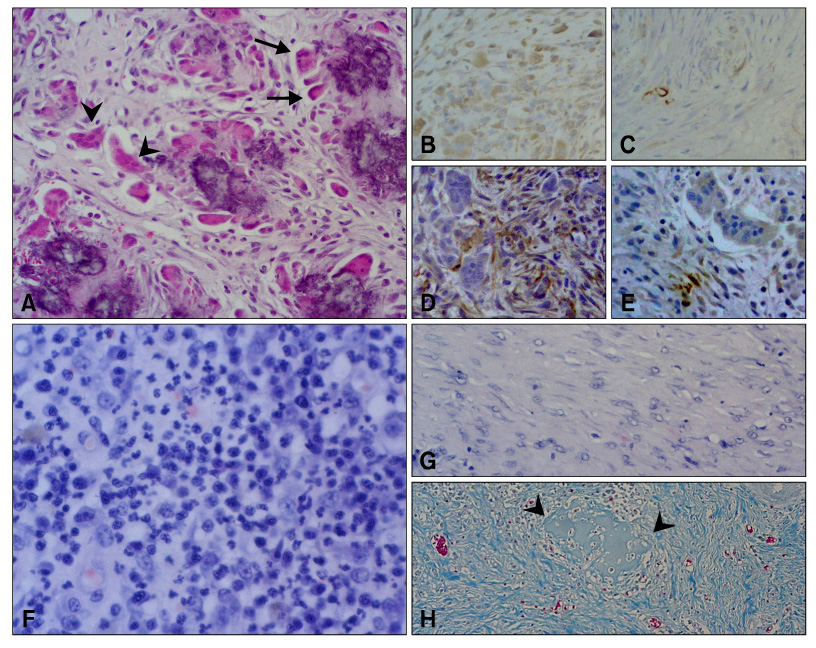J Vet Sci.
2009 Jun;10(2):169-171. 10.4142/jvs.2009.10.2.169.
Two different types of malignant fibrous histiocytomas from pet dogs
- Affiliations
-
- 1Department of Clinical Pathology, College of Veterinary Medicine, Konkuk University, Seoul 143-701, Korea.
- 2Department of Pathology, College of Veterinary Medicine, Kyungpook National University, Daegu 702-701, Korea. jeongks@knu.ac.kr
- KMID: 1102976
- DOI: http://doi.org/10.4142/jvs.2009.10.2.169
Abstract
- We describe 2 cases of malignant fibrous histiocytomas (MFHs) that spontaneously developed in young pet dogs. To classify these tumors, we applied a panel of antibodies (vimentin, desmin, alpha-SMA, and ED1) and Azan staining for collagen. The MFHs were most consistent with osteoclast-like giant and inflammatory cell types. The first case had positive staining for ED1 and vimentin, and given the osteoclast-like giant cells, calcification sites accompanying peripheral giant cell infiltrates. The latter case, the inflammatory cell type, exhibited a storiform-pleomorphic variant of neoplastic cells, including an ossifying matrix. MFHs are among the most highly aggressive tumors occurring in soft tissue sarcomas in elderly dogs; however, MFHs have been poorly studied from a diagnostic point of view. Herein, we describe the histologic and immunohistologic features of MFHs in detail, thus classifying the subtypes of these tumors.
MeSH Terms
Figure
Reference
-
1. Carip C, de Beaumont T. Malignant histiocytofibroma of the small intestine in a young immune deficient patient. Presse Med. 2002. 31:214–216.2. Folpe AL, Morris RJ, Weiss SW. Soft tissue giant cell tumor of low malignant potential: a proposal for the reclassification of malignant giant cell tumor of soft parts. Mod Pathol. 1999. 12:894–902.3. Gregory M, Barbara EP, Dennis M, Stephen JW. Small Animal Clinical Oncology. 2001. 3rd ed. Pennsylvenia: Saunders;283–287.4. Lew W, Lim HS, Kim YC. Cutaneous metastatic malignant fibrous histiocytoma. J Am Acad Dermatol. 2003. 48:S39–S40.
Article5. Morris JS, McInnes EF, Bostock DE, Hoather TM, Dobson JM. Immunohistochemical and histopathologic features of 14 malignant fibrous histiocytomas from Flat-Coated Retrievers. Vet Pathol. 2002. 39:473–479.
Article6. Orlandi A, Bianchi L, Ferlosio A, Innocenzi I, Spagnoli LG. The origin of osteoclast-like giant cells in atypical fibroxanthoma. Histopathology. 2003. 42:407–410.
Article7. Pérez-Martínez C, García Fernnádez RA, Reyes Avila LE, Pérez-Pérez V, González N, García-Iglesias MJ. Malignant fibrous histiocytoma (giant cell type) associated with a malignant mixed tumor in the salivary gland of a dog. Vet Pathol. 2000. 37:350–353.
Article8. Rebecca B, John HL. Color Atlas of Cytology of the Dog and Cat. 2000. Missouri: Mosby;46.9. Kaddu S, McMenamin ME, Fletcher CD. Atypical fibrous histiocytoma of the skin: clinicopathologic analysis of 59 cases with evidence of infrequent metastasis. Am J Surg Pathol. 2002. 26:35–46.10. Wiriosuparto S, Krassilnik N, Gologan A, Cohen JM, Wenig B. Malignant fibrous histiocytoma, giant cell type, of the breast mimicking metaplastic carcinoma. A case report. Acta Cytol. 2003. 47:673–678.
Article
- Full Text Links
- Actions
-
Cited
- CITED
-
- Close
- Share
- Similar articles
-
- Ultrastructure of 2 Malignant Fibrous Histiocytomas with Reference to the Histogenesis
- ras Gene Mutations in Malignant Fibrous Histiocytoma
- A Case of Malignant Fibrous Histiocytoma in the Conjunctiva
- Expression of Matrix Metalloproteinase-9 Correlates with Poor Prognosis in Human Malignant Fibrous Histiocytoma
- Malignant Fibrous Histiocytoma of the Stomach - A case repot -


